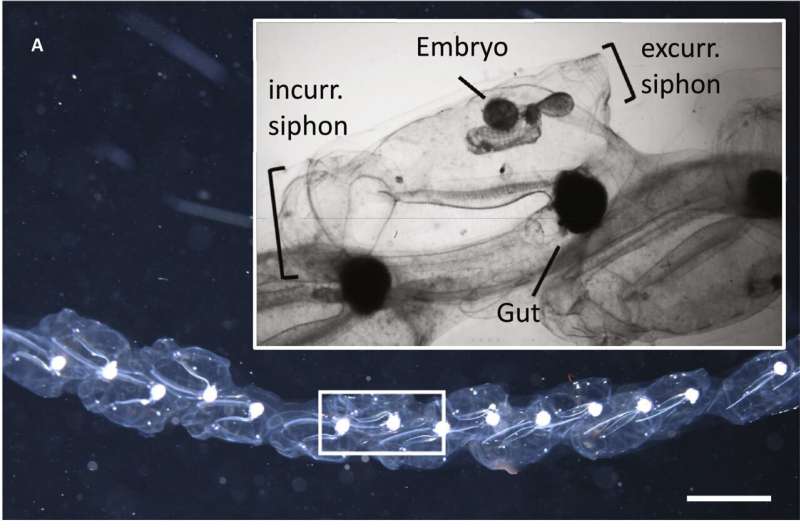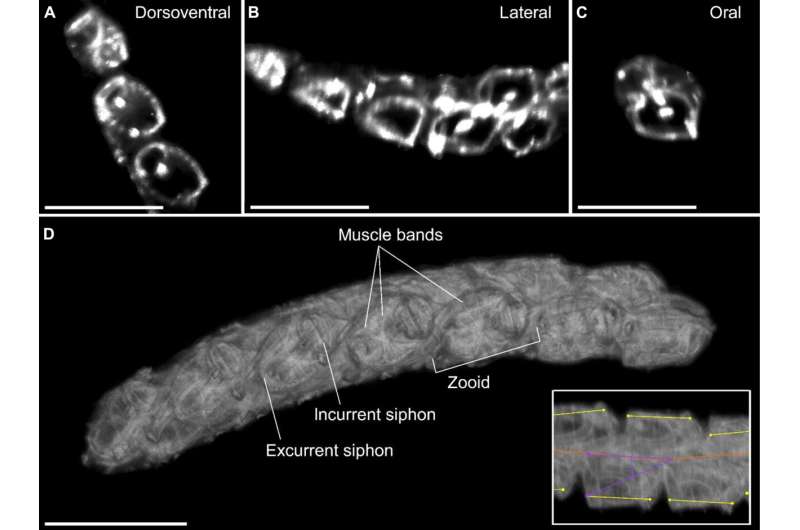This article has been reviewed according to Science X's editorial process and policies. Editors have highlighted the following attributes while ensuring the content's credibility:
fact-checked
peer-reviewed publication
trusted source
proofread
Researchers uncover how jelly sea creatures might shape modern robotics

Scientists at the University of Oregon have discovered that colonies of gelatinous sea animals swim through the ocean in giant corkscrew shapes using coordinated jet propulsion, an unusual kind of locomotion that could inspire new designs for efficient underwater vehicles.
The research involves salps, small creatures that look similar to jellyfish that take a nightly journey from the depths of the ocean to the surface. Observing that migration with special cameras helped UO researchers and their colleagues capture the macroplankton's graceful, coordinated swimming behavior.
"The largest migration on the planet happens every single night: the vertical migration of planktonic organisms from the deep sea to the surface," said Kelly Sutherland, an associate professor in biology at the UO's Oregon Institute of Marine Biology, who led the research. "They're running a marathon every day using novel fluid mechanics. These organisms can be platforms for inspiration on how to build robots that efficiently traverse the deep sea."
The researchers' findings were published May 15 in the journal Science Advances. The study included collaborations from Louisiana Universities Marine Consortium, University of South Florida, Roger Williams University, Marine Biological Laboratory and Providence College.
Despite looking similar to jellyfish, salps are barrel-shaped, watery macroplankton that are more closely related to vertebrates like fish and humans, said Alejandro Damian-Serrano, an adjunct professor in biology at the UO. They live far from shore and can live either as solitary individuals or operate in colonies, he said. Colonies consist of hundreds of individuals linked in chains that can be up to several meters long.
"Salps are really weird animals," Damian-Serrano said. "While their common ancestor with us probably looked like a little boneless fish, their lineage lost a lot of those features and magnified others. The solitary individuals behave like this mothership that asexually breeds a chain of individual clones, cojoined together to produce a colony."
But the most unique thing about these ocean creatures was found during the researchers' ocean expeditions: their swimming techniques.
Exploring off the coast of Kailua-Kona, Hawaii, Sutherland and her team developed specialized 3D camera systems to bring their lab underwater. They conducted daytime scuba dives, "immersed in infinite blue," as Damian-Serrano described, for high visibility investigations.

They also performed nighttime dives, when the black backdrop allowed for high-contrast imaging of the transparent critters. They encountered an immense flurry of different salps that were doing their nightly migration to the surface—and many photobombing sharks, squids and crustaceans, Sutherland noted.
Through imaging and recordings, the researchers noticed two modes of swimming. Where shorter colonies spun around an axis, like a spiraling football, longer chains would buckle and coil like a corkscrew. That's called helical swimming.
Helical swimming is nothing new in biology, Sutherland said. Many microorganisms also spin and corkscrew through water, but the mechanisms behind the salps' motion are different. Microbes beat water with hair-like projections or tail whips, but salps swim via jet propulsion, Sutherland said. They have contracting muscle bands, like those in the human throat, that pump water sucked from one side of the body and squirted out the other end to create thrust, Damian-Serrano said.
The researchers also noticed that individual jets contracted at different times, causing the whole colony to steadily travel without pause. The jets were also angled, contributing to the spinning and coil swimming, Sutherland said.
"My initial reaction was really one of wonder and awe," she said. "I would describe their motion as snake-like and graceful. They have multiple units pulsing at different times, creating a whole chain that moves very smoothly. It's a really beautiful way of moving."
Microrobots inspired by microbial swimmers already exist, Sutherland said, but this discovery paves the way for engineers to construct larger underwater vehicles. It may be possible to create robots that are silent and less turbulent when modeled after these efficient swimmers, Damian-Serrano said. A multijet design also may be energetically advantageous for saving fuel, he said.
Beyond microbes, larger organisms like plankton have yet to be described in this way, Sutherland said. With Sutherland's new and innovative methods of studying sea creatures, scientists might come to realize that helical swimming is more pervasive than previously thought.
"It's a study that opens up more questions than provides answers," Sutherland said. "There's this new way of swimming that hadn't been described before, and when we started the study we sought to explain how it works. But we found that there are a lot more open questions, like what are the advantages of swimming this way? How many different organisms spin or corkscrew?"
More information: Kelly R. Sutherland et al, Spinning and corkscrewing of oceanic macroplankton revealed through in situ imaging, Science Advances (2024). DOI: 10.1126/sciadv.adm9511
Journal information: Science Advances
Provided by University of Oregon



















